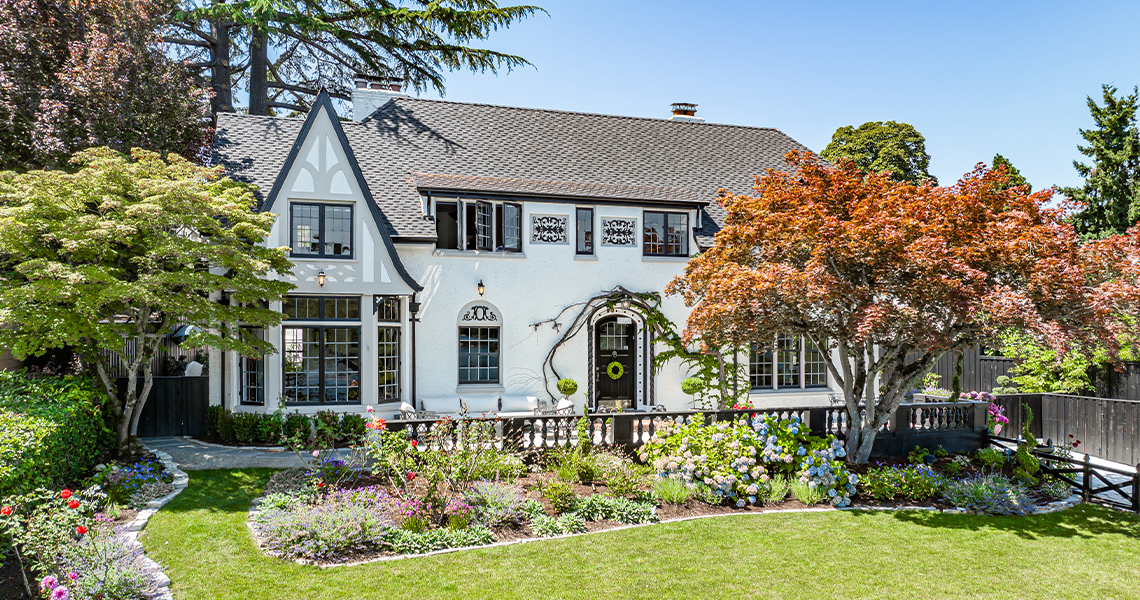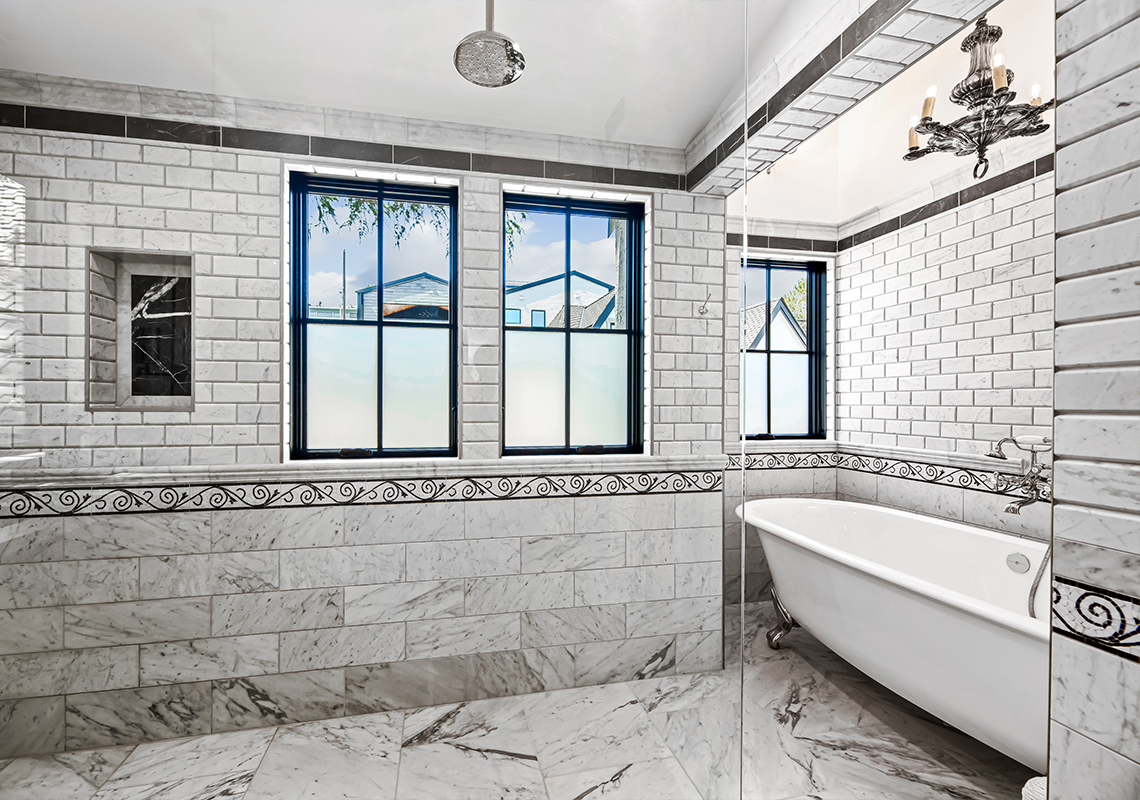Vital Stats
|
Single Family Remodel
|
Single Family New Construction
|
Location: Seward Park, Seattle
Star Level: 5-Star, NZE
Checklist: 2009 Remodel and 2017 Single Family/Townhome New Construction
Verifier: Evergreen Certified |
Site and Water: 79 |
Site and Water: 151 |
| Energy Efficiency: 177 |
Energy Efficiency: 175 |
| Health and Indoor Air Quality: 138 |
Health and Indoor Air Quality: 141 |
| Material Efficiency: 85 |
Material Efficiency: 102 |
| |
Total Score: 483 |
Total Score: 624 |
Just north of the entrance to Seward Park, directly across from the water’s edge resides The Lake House. Built in 1919, the historical home was designed by renowned California-raised architect, Edwin Ivey, in the Spanish Eclectic style reminiscent of the homes found in Pasadena. A street-to-street lot, prime location, and a magical facade sparked the interest of the founders of Dwell Development (Dwell), Abbey and Anthony Maschmedt. For them, it was love at first sight. Their challenge was taking the sustainability practices they employ in new homes and implementing them in a home over a century old. It was a challenge they fully embraced when they devised their plan for The Lake House 2.0.

Dwell set out to do something extraordinary with this amazing parcel located on Lake Washington Boulevard South. Their job was to solve the puzzle of taking advantage of a unique development opportunity while maintaining the original integrity of the existing home—with a little over 20,000 square feet there were endless possibilities.
Fortunately, the existing home sat on the front portion of the lot with a massive grass front yard facing the lake. Behind the house, there was an existing carriage garage, that was originally intended for a vehicle and a caretaker. Beyond the garage was a large, landscaped yard that fronted 57th Avenue South. The site being street to street, provided room for development and design.
In most cases, similarly zoned sites would see the existing house demolished, then subdivided to create 3 new approximately 7,000-square-foot parcels, with 3 new single-family homes built. However, the Lake House was architecturally significant, and while it would take a lot of work to modernize it for another century of use, the Maschmedts knew that preservation had to be the goal. Then again part of modernization is also using resources more wisely, and land and housing are finite resources. So they had to also re-envision the site to maximize such valuable resources. Ultimately, they decided to preserve the Lake House with a new DADU and office, then subdividing it into two parcels to build a new single family home with an accessory dwelling unit. This increased the housing capacity of the site to 4 housing units.
Curve balls are expected when planning a project like this, but the Covid-19 pandemic presented unique challenges when it came to design decisions. During the pandemic Seattle Parks, which owns Lake Washington Boulevard, had decided to shut down the boulevard regularly to accommodate pedestrians, bikes, and strollers. Continual access from the back of the Lake House needed to be maintained, because there was a looming threat of a permanent shutdown of the boulevard to cars.
The biggest obstacle of the project would be updating the existing single-family home. Though Dwell is well-versed in sustainable new construction, historical restoration was not on their resume yet. They needed to balance preserving the amazing home, saving it from the landfill and maintaining its original charm and character, while updating and modernizing it to assure it met all the expected energy efficiency of a Dwell Development home. Ultimately, the goal was for The Lake House 2.0 to be Dwell’s first Net Zero Energy renovation.
Inclusive of the down-to-the-studs renovation of the existing home, the existing carriage garage was demolished and replaced with their first Net Zero Energy DADU. The DADU includes a 2-car garage that is accessed off of 57th Avenue South and serves as the new Dwell Development office headquarters. In addition, another first for Dwell, a Net Zero Energy Ready 5-Star Built Green single-family home with a legal AADU was built on the remaining portion of the parcel in the rear overlooking the main house and the lake.

Dwell applied all their standard, tried and true, sustainable systems and practices to the project. The existing house was stripped down to the studs, and a 1,500 sq ft addition was added to the back. Originally built with no insulation, they knew that proper insulation would be critical. After removing all the plaster and lathe, they added blown-in cellulose insulation. The exterior was also clad in a rain-screen Portland Cement Stucco, a cladding very unusual for the Northwest. The new stucco on the addition would need to match perfectly to blend old and new. No stone was left unturned in preservation. Existing millwork, windows, light fixtures, and doors were removed, stored, and eventually returned to their rooms. Their goal was to avoid waste and reuse as much of it as possible.
Heating and cooling and air quality are essential to a sustainable home. Anthony and Abbey called on trusted manufacturers, because they knew they couldn’t do it all alone. Partnerships were essential to the project. Mitsubishi and Panasonic lent Dwell their HVAC and fresh air consultants to design a new type of state-of-the-art heating/cooling and fresh air system. They also donated all the equipment towards this never-used-before system. The HVAC system features an ERV integrated into the ducted heat pump air handler to provide triple filtration and air scrubbing, maintaining premium fresh air and thermal comfort throughout the home.
The Lake House and its DADU is designed for a 16kW solar PV array that provides it a net positive energy balance. The solar PV will not only power the home and DADU, but also the swimming pool and an electric vehicle. The single family home is solar PV ready and includes two level II charging outlets for EVs.
The final results are something Dwell Development is very proud of. A feather in their cap and a homage to sustainability. Having completed a 5-Star Net Zero Energy Certified Built Green renovation, a 5-Star Net Zero Energy Certified Built DADU, and a 5-Star Built Green Net Zero Energy Ready Single-Family Residence with AADU simultaneously in one project, Anthony and Abbey Maschmedt of Dwell Development believe anything is possible when you set your mind to it. Lake House 2.0 is ready to roll into the next one hundred years.